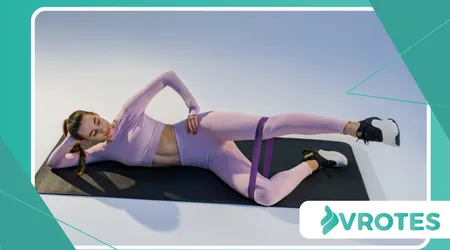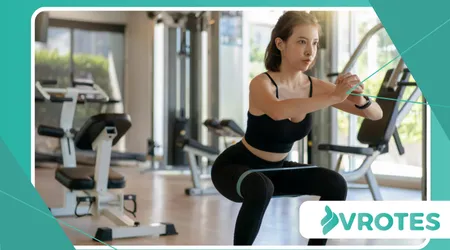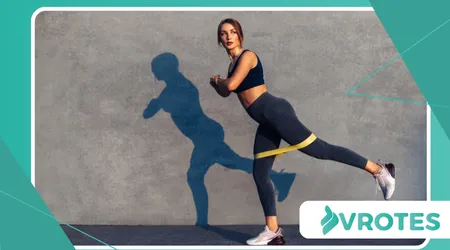Resistance Bands: Full-Body Routine for Bone Strength

Resistance bands. As we navigate the exciting journey of midlife, maintaining strong bones becomes not just a goal, but a vital cornerstone for a vibrant future.
Anúncios
Forget heavy weights and intimidating gym equipment; the secret to robust bone health might just be in your hands – specifically, in a set of versatile resistance bands.
These unassuming tools offer a revolutionary path to building density and resilience, right from the comfort of your home or on the go.
Why Bone Strength Matters More Than Ever in Midlife
Midlife marks a significant physiological shift, particularly concerning bone density.
After our peak bone mass, typically reached in our late 20s or early 30s, a gradual decline often begins. This natural process accelerates, especially for women after menopause due to hormonal changes.
Anúncios
Strong bones are our framework, supporting every movement and protecting our vital organs. Neglecting them can lead to increased fracture risk, impacting mobility and quality of life.
The Silent Threat: Osteoporosis
Osteoporosis, often called the “silent disease,” progresses without symptoms until a fracture occurs.
It’s characterized by bones becoming weak and brittle. Understanding this risk is crucial for proactive measures. Incorporating weight-bearing and resistance exercises is paramount in this fight.
Beyond Calcium: A Holistic Approach
While calcium and vitamin D are vital, they’re only part of the puzzle. Bone health is a complex interplay of nutrition, lifestyle, and crucially, physical activity.
Read here: Barre Workouts That Tone Muscles Safely in Menopause
Exercise, particularly resistance training, stimulates bone cells, encouraging them to lay down new bone tissue.
The Power of Resistance Bands for Bone Building
Resistance bands offer a unique advantage in bone-building workouts. Unlike free weights, they provide constant tension throughout the entire range of motion.
This sustained resistance challenges your muscles and, by extension, your bones, in a way that traditional weights sometimes cannot. They’re also incredibly portable, affordable, and adaptable to all fitness levels.

Progressive Overload, Simplified
The principle of progressive overload is key to building strength and bone density. It means gradually increasing the demands on your body.
See how interesting: Yoga Poses That Balance Hormones and Reduce Hot Flashes
With resistance bands, you can easily achieve this by using thicker bands, performing more repetitions, or increasing the time under tension.
This continuous challenge signals your bones to adapt and strengthen.
Low Impact, High Reward
For many in midlife, joint health is a consideration. Resistance band exercises are generally low-impact, minimizing stress on your joints while still delivering powerful bone-strengthening benefits.
This makes them an excellent choice for those with existing joint issues or as a preventive measure.
Your Full-Body Bone-Strengthening Routine with Resistance Bands
This routine targets major muscle groups, providing a comprehensive stimulus for bone growth throughout your body.
Remember to warm up for 5-10 minutes with light cardio and dynamic stretches before starting.
Perform 2-3 sets of 10-15 repetitions for each exercise, resting for 60-90 seconds between sets. Listen to your body and adjust the resistance as needed.
Upper Body: Arms, Shoulders, and Chest
1. Band Pull-Aparts
Hold a band with an overhand grip, hands shoulder-width apart, arms extended forward at chest height. Keep your core engaged.
++ Breathing Exercises to Instantly Center Yourself During a Flare-Up
Pull the band apart, squeezing your shoulder blades together. Control the return. This targets your upper back and shoulders, crucial for spinal health.
2. Banded Chest Press
Loop a long band around your back, holding one end in each hand. Lie on your back, knees bent, feet flat. Press your hands forward as if doing a bench press.
This strengthens your chest and triceps, supporting upper body posture.

3. Bicep Curls with Band
Stand on the middle of the band, holding an end in each hand, palms facing forward. Keep your elbows tucked in. Curl your hands towards your shoulders, squeezing your biceps. Slowly lower.
Lower Body: Legs and Glutes
1. Banded Squats
Place a loop band just above your knees. Stand with feet shoulder-width apart. Push your hips back and lower into a squat, keeping tension on the band by pushing your knees out.
This engages your glutes and quads, directly impacting hip and femur bone density.
2. Glute Bridges with Band
Lie on your back, knees bent, feet flat, with a loop band above your knees.
Press through your heels and lift your hips off the ground, squeezing your glutes. Ensure your knees stay pushed out against the band. Lower slowly.
3. Banded Lateral Walks
Place a loop band around your ankles or just above your knees. Take small, controlled steps to the side, maintaining tension on the band. Keep your core stable.
This targets your hip abductors, important for balance and hip stability.
Core: Stability and Support
1. Banded Pallof Press
Anchor a band at chest height to a sturdy object. Stand perpendicular to the anchor, holding the band with both hands at your chest
. Press the band straight out, resisting the pull to rotate. Hold briefly and return. This powerfully engages your core stabilizers, protecting your spine.
The Science Behind the Snap: How Resistance Builds Bones
When you engage your muscles against resistance, a fascinating biological process unfolds.
The pulling and pushing forces exerted by your muscles on your bones create microscopic stresses. These stresses are interpreted by specialized cells within your bones, called osteoblasts and osteoclasts, as a signal to adapt.
Osteoblasts, the bone-building cells, get to work, laying down new bone tissue and increasing density. This adaptive response is why weight-bearing and resistance exercises are so effective.
It’s like a tiny, internal construction crew constantly reinforcing your skeletal structure.
For example, consider the impact of walking versus running. Both are weight-bearing, but running imposes greater impact forces on your bones, stimulating a stronger adaptive response.
Similarly, lifting a heavy object or performing an exercise with resistance bands provides a direct stimulus that signals your bones to become stronger.
A notable study published in the Journal of Bone and Mineral Research highlighted that progressive resistance training, even in older adults, significantly improves bone mineral density at critical sites like the hip and spine.
Integrating Resistance Bands into Your Lifestyle
Consistency is paramount when it comes to bone health. Aim for at least 3-4 sessions of resistance band training per week.
You can combine it with other activities like walking, dancing, or cycling. The beauty of resistance bands is their adaptability.
Traveling? Toss them in your bag. Short on time? A quick 20-minute routine can still be highly effective.
| Exercise Type | Primary Bone Target | Benefit for Midlife |
| Squats (Banded) | Femur, Pelvis, Spine | Hip and lower spine density, balance |
| Glute Bridges (Banded) | Pelvis, Femur, Spine | Hip strength, fall prevention |
| Overhead Press (Banded) | Humerus, Scapula, Spine | Upper body strength, posture |
| Rows (Banded) | Scapula, Humerus, Spine | Back strength, posture, spinal density |
| Lateral Walks (Banded) | Femur, Pelvis | Hip abduction strength, balance, stability |
Think of your bones as a bank account. Every time you engage in resistance training, you’re making a deposit.
If you stop exercising, you start making withdrawals. To ensure a healthy balance, consistent deposits are crucial.
This isn’t about becoming a bodybuilder; it’s about investing in your long-term skeletal health.
How often do we prioritize short-term gains over enduring wellness?
Beyond the Bands: A Holistic Approach to Bone Health
While resistance bands are incredible, remember they’re part of a larger bone health ecosystem.
Ensure adequate intake of calcium-rich foods (dairy, leafy greens, fortified plant milks) and vitamin D (sun exposure, fatty fish, fortified foods). Magnesium, vitamin K2, and phosphorus also play critical roles.
Avoid smoking and excessive alcohol consumption, both of which can negatively impact bone density.
Manage stress, as chronic stress can affect hormone balance. Prioritize quality sleep, as it’s essential for overall body repair and regeneration.
Talk to your doctor about bone density screenings, especially if you have risk factors for osteoporosis. Early detection allows for timely interventions.
The Enduring Strength Within You
Embracing resistance bands for bone strength is more than just a workout; it’s an empowering declaration of self-care in midlife.
It’s about harnessing simple yet effective tools to build a stronger, more resilient you from the inside out. With consistency and a holistic approach, you can fortify your bones and continue to live a life full of movement, joy, and unwavering strength.
Your skeleton is the unsung hero of your body; it’s time to give it the attention it deserves.
Frequently Asked Questions
Are resistance bands truly effective for building bone density?
Yes, absolutely! Resistance bands provide an effective form of progressive overload, which is essential for stimulating bone cells to deposit new tissue.
The constant tension they offer challenges your muscles and bones, promoting bone growth and strengthening.
How long does it take to see results in bone density with resistance bands?
A: Building bone density is a gradual process. With consistency and a well-structured program, you can start to notice improvements in muscle strength within a few weeks and in bone density over several months to a year. It’s a long-term investment in your skeletal health.
Can I use resistance bands if I have osteoporosis?
It’s crucial to consult your doctor or a physical therapist before starting any new exercise program if you have osteoporosis.
However, in many cases, resistance band exercises are recommended as they are low-impact and can be adapted to be safe and effective in improving muscle and bone strength, under professional guidance.
What type of resistance band should I buy?
There are various types of resistance bands, including loop bands, flat bands, and tubes with handles.
For a full-body routine, a set of loop bands with different resistances (light, medium, heavy) is an excellent starting point, as they offer versatility for a wide range of exercises.
Can I substitute free weights with resistance bands to build strong bones?
Resistance bands are an excellent alternative or complement to free weights. While both are effective for bone building, bands offer continuous resistance and are easier on the joints.
For many middle-aged individuals, they are a more accessible and practical option. Ideally, using a combination of both, if possible, will yield the best results.
++ Exercise helps keep bones strong and healthy throughout your life.
